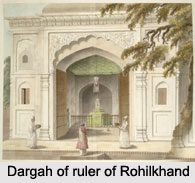 Medieval History of Bareilly began with the construction of the city Bareilly by a Rajput and the insurgence of Rohillas in Rohillakhand, which was later diminished brutally by the Nawab of Awadh and the British East India Company in India.
Medieval History of Bareilly began with the construction of the city Bareilly by a Rajput and the insurgence of Rohillas in Rohillakhand, which was later diminished brutally by the Nawab of Awadh and the British East India Company in India.
Bareilly and Delhi Sultanate
It was 13th century when the Delhi Sultanate based kingdoms or sultanates was firmly established, Katehr was divided into the provinces of Sambhal and Budaun. But the thickly forested country infested with wild animals provided just the right kind of shelter for rebels. And indeed, Katehr was famous for rebellions against imperial authority of Delhi. During the Sultanate rule, there were frequent rebellions in Katehr. All were ruthlessly crushed. Sultan Ghiayasuddin Balban ordered vast tracts of jungle to be cleared so as to make the area unsafe for the rebels.
Bareilly under Mughal Rule
 The Mughals, after the decline of Delhi Sultanate in India, initiated the policy of allotting lands for Afghan settlements in Katiher. Afghan settlements continued to be encouraged throughout the reign of Aurangzeb and even after his death. These Afghans, known as the Rohilla Afghans, caused the area to be known as Rohilkhand. This move by Mughal emperor Aurangzeb was aimed to suppress Rajput uprisings, which had afflicted this region. Originally, some 20,000 soldiers from various Pashtun Tribes (Yusafzais, Ghoris, Lodis, Ghilzai, Barech, Marwat, Durrani, Tanoli, Tarin, Kakar, Khattak, Afridi and Baqarzai ) were hired by Mughals to provide soldiers to the Mughal armies and this was appreciated by Aurangzeb, an additional force of 25,000 men were given respected positions in Mughal Army. However most of them settled in the Katehar region during Nadir Shah`s invasion of northern India in 1739 increasing their population up to 10,00,000. Due to the large settlement of Rohilla Afghans, the Katehar region gained fame as Rohilkhand.
The Mughals, after the decline of Delhi Sultanate in India, initiated the policy of allotting lands for Afghan settlements in Katiher. Afghan settlements continued to be encouraged throughout the reign of Aurangzeb and even after his death. These Afghans, known as the Rohilla Afghans, caused the area to be known as Rohilkhand. This move by Mughal emperor Aurangzeb was aimed to suppress Rajput uprisings, which had afflicted this region. Originally, some 20,000 soldiers from various Pashtun Tribes (Yusafzais, Ghoris, Lodis, Ghilzai, Barech, Marwat, Durrani, Tanoli, Tarin, Kakar, Khattak, Afridi and Baqarzai ) were hired by Mughals to provide soldiers to the Mughal armies and this was appreciated by Aurangzeb, an additional force of 25,000 men were given respected positions in Mughal Army. However most of them settled in the Katehar region during Nadir Shah`s invasion of northern India in 1739 increasing their population up to 10,00,000. Due to the large settlement of Rohilla Afghans, the Katehar region gained fame as Rohilkhand.
Formation of Bareilly
The city of Bareilly was founded in 1537 by Basdeo, a Rajput. The city is mentioned in the history of India for the first time by Budayuni who writes that one Husain Quli Khan was appointed the governor of `Bareilly and Sambhal` in 1568. The divisions and revenue of the district being fixed by Todar Mal were recorded by Abul Fazl in 1596. The foundation of the `modern` City of Bareilly was laid by Mukrand Rai in 1657. In 1658, Bareilly was made the headquarters of the province of Budaun.
Bareilly and Rohillakhand
Bareilly becomes the place for Rohillas to suppress Rajputs during the time of Aurangzeb. In 1623 two Afghan brothers of the Barech tribe, Shah Alam and Husain Khan, settled in the region, bringing with them many other Pashtun settlers. It was with the immigration of Daud Khan, an Afghan slave in the region that the Afghan Rohillas had come into prominence. His adopted son Ali Muhammad Khan succeeded in carving out an estate for himself in the district with his headquarters in the region. He was ultimately made the lawful governor of Kateher by the Mughal emperor Aurangzeb, and the region was henceforth called "the land of the Ruhelas". Eventually after the end of the Mughal Empire many Pathans migrated from `Rohilkhand`.



















